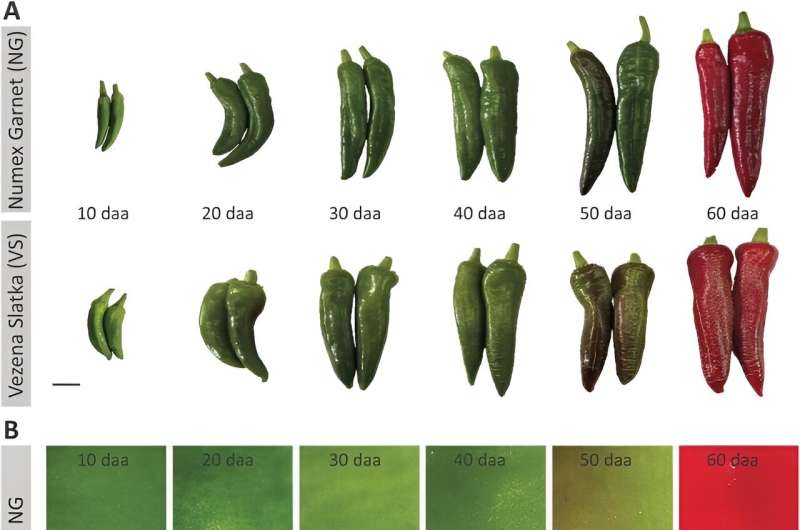This article has been reviewed according to Science X's editorial process and policies. Editors have highlighted the following attributes while ensuring the content's credibility:
fact-checked
peer-reviewed publication
trusted source
proofread
Unlocking the mystery of skin cracking in chili peppers

The outermost epidermal cell layer of fleshy fruit is surrounded by a hydrophobic cuticle, notably thicker than that found on vegetative tissues. This cuticle, primarily composed of the cutin polymer, also contains waxes and sometimes polysaccharides. It serves crucial functions, including regulating water and gas transport, protection against pathogens, and shielding from UV radiation. Failure of the fruit skin, which can manifest in ways ranging from browning to cracking, negatively impacts the fruit's development, appearance, and marketability.
When the skin is damaged, some fruits can heal by forming a secondary tissue comprising suberin and lignin polymers. However, the exact reasons behind fruit skin cracking and the sequence of events leading to it remain inadequately understood.
Horticulture Research published a research paper entitled "Microscopic and metabolic investigations disclose the factors that lead to skin cracking in chili-type pepper fruit varieties."
In this study, researchers examined two varieties: Numex Garnet with intact skin, and Vezena Slatka with cracked skin to understand the causes of skin cracking in chili peppers (Capsicum annuum L.).
However, light and scanning electron microscopy (SEM) showed that while Numex Garnet maintained its skin integrity, Vezena Slatka's skin exhibited severe cracking perpendicular to the fruit's longitudinal axis. Via gas chromatography–mass spectrometry (GC–MS), significant differences in cutin monomer contents between the two varieties were identified. Particularly, Vezena Slatka had higher cutin content, attributed to certain fatty acids and hydroxycinnamic acids.
Measurement of cuticle thickness indicated Vezena Slatka developed a substantially thicker cuticle. Furthermore, Vezena Slatka fruit showed lower epidermal cell density due to cells with larger perimeters. Despite similar expression patterns of key cutin biosynthesis genes in both chilies, Vezena Slatka highly expresses genes involved in epidermal cell differentiation, affecting the biochemical composition of the stratum corneum.
Using the Wiesner procedure with Phloroglucinol, researchers found significant lignin-like polyphenolic compounds in the cracked regions of Vezena Slatka fruit, but not in the Numex Garnet fruit.
Quantitative analysis further showed high lignin content in the Vezena Slatka fruit. To further substantiate these findings, histological skin sections from both fruit types were stained with phloroglucinol and potassium permanganate, revealing an increased presence of lignin in the Vezena Slatka fruit from the appearance of cracks onward.
Another staining method using toluidine blue O (TBO) highlighted the presence of lignin-related polyphenolic compounds in the Vezena Slatka fruit's skin. Comprehensive histological analyses provided robust evidence for lignin accumulation in cracked regions of the Vezena Slatka fruit. This was further supported by gene expression analyses that revealed elevated levels of key lignin genes in the Vezena Slatka fruit compared to the Numex Garnet.
The post-harvest studies highlighted that Vezena Slatka fruit with cracked skin demonstrated higher weight loss, increased CO2 respiration, and greater ion leakage and MDA content, especially when stored at elevated temperatures. In addition, post-harvest storage led to decreased skin cutin content in both fruit types, with Vezena Slatka fruit displaying more pronounced reductions.
In summary, these findings offer valuable insights into improving post-harvest fruit preservation and understanding skin cracking determinants in chili peppers.
More information: Ofir Marinov et al, Microscopic and metabolic investigations disclose the factors that lead to skin cracking in chili-type pepper fruit varieties, Horticulture Research (2023). DOI: 10.1093/hr/uhad036
Journal information: Horticulture Research
Provided by NanJing Agricultural University





















